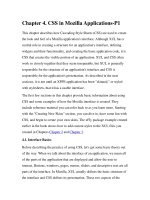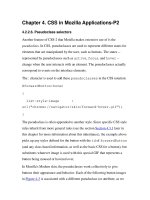Lesson LPI 202: Chapter 4 - Advancer Linux Netword Administration Mail services
Bạn đang xem bản rút gọn của tài liệu. Xem và tải ngay bản đầy đủ của tài liệu tại đây (347.5 KB, 30 trang )
Chapter 04
Advanced Linux Network
Administration
Mail services
1
SaigonCTT All rights reserved
Objectives
• SMTP Protocol
• Using Sendmail
• Configuring mailing lists
• Managing Mail Traffic
2
LPI Linux
SMTP Protocol
• Server is at TCPport 25
• Currently undeliverable messages can (and should) be queued
• RelatedStandards
– RFC2821: Defines transferprotocol
– RFC2822: Defines messageform
– These are updated by many other RFCs
– RFC 1123: Internet Host Requirements
– RFC 1870, 2821: SMTP Service Extensions
– RFC 18911895: Even more extensions, now obsoleted by newer RFCs
– RFCs 20452049: MIME
3
LPI Linux
Mail agents
• Mail User Agents
– MUAs are the source and destination of email
– Pine, Microsoft Outlook, MH, Mozilla, Elm, mail etc.
• Mail Transfer Agents
– MTAs transport and route the messages from the sender’s MUA to the
recipient’s MUA
– This is applications level routing and similar to but not related to IP
routing
– The decision is made based on the recipient’s address
– Spam blocking is an exception
– The recipient’s address may be changed
– E.g. email aliases, .forward
4
LPI Linux
The eMail Message’s Journey
• The message in the SMTPstandard consists of two parts
– The envelope is information transmitted using SMTP protocol units
– The contents includes the headers and body of the message
• The MUA receives the message from the end user and
interprets the correct sender and receiver information
• The message is passed to the MTA for transportation over the
network
– Usually the message is first stored in a spool directory to wait until it can
be transmitted to the next MTA
– At the destination the message is placed into the recipient’s mailbox
– usually a file, can also be a directory or a database
• In practice the distinction between modern MTA and MUA
software is not always clear
5
LPI Linux
Sample SMTP Session Initiation
riku@mole $ telnet nixugw.nixu.fi 25
Trying 194.197.118.1...
Connected to nixugw.nixu.fi.
220 nixugw.nixu.fi ESMTP Sendmail 8.9.3/8.9.3; Tue, 13 Apr 1999 13:40:05 +0300
HELP
214This is Sendmail version 8.9.3
214Topics:
214 HELO EHLO MAIL RCPT DATA
214 RSET NOOP QUIT HELP VRFY
214 EXPN VERB ETRN DSN
214For more info use "HELP <topic>".
214To report bugs in the implementation send email to
214 sendmail
214For local information send email to Postmaster.
214 End of HELP info
EHLO mole.nixu.fi
250nixugw.nixu.fi Hello mole.nixu.fi [194.197.118.22], pleased to meet you
2508BITMIME
250SIZE
250DSN
250XUSR
250 HELP
6
LPI Linux
Sending the Message in SMTP
MAIL From: <>
250 <>... Sender ok
RCPT To: <>
250 <>... Recipient ok
DATA
354 Enter mail, end with "." on a line by itself
From: <>
To: <>
Subject: foobar
Demo material for SMTP course
.
250 NAA12630 Message accepted for delivery
QUIT
221 nixugw.nixu.fi closing connection
Connection closed by foreign host.
19 riku@mole $
7
LPI Linux
The Message Structure
• The envelope contains the MTA’s view of the sender and
receiver
– This is why you receive complaints about viruses and spam you have
not sent
– These are transported in the MAIL FROM and RCPT TO commands of
the SMTP protocol
– Notice the difference between the "From:" in the message headers and
the "From" in the envelope
• Headers
– From the beginning of the content until the first empty line
– Format is "fieldname: field body"
– Some are mandatory, some not
• Body
– After first empty line until the end of the message
8
LPI Linux
SMTP and DNS
• MXs
– Mail eXchanger records in DNS
– Enables mail forwarding in cases where access to customers mail
server is limited
– Example: part of sral.fi MXs
•
sral.fi. IN MX 1 bar.foo.fi.
•
sral.fi. IN MX 10 smtp3.kolumbus.fi.
• Logic: Mail is transferred only closer to destination
– Smaller MXvalue means that machine is closer to destination
– Machine with the smallest MXvalue is tried first, then the machine with
the next smallest and so on...
9
LPI Linux
SMTP and DNS
•
Explicit MXs
– Defined MXs
– e.g. sral.fi. IN MX 1 bar.foo.fi.
•
Implicit MXs
– If a machine has an IPaddress, is also has an implicit MX with value of 0
– e.g. bar.foo.fi. IN A 193.209.237.254
•
WildcardMXs
– If a whole domain is handled by one server, it can be configured with a wildcard
MX
– Use with caution (wrong configuration causes “tennis tournaments”)!
– e.g. *.wild.fi. IN MX 1 mail.wild.fi.
•
Order of use: explicitimplicitwildcard
– If none found: Host unknown
•
Errors in DNS are critical! Mail can not be delivered without functioning
name service
10
LPI Linux
Sendmail
• The most common MTA and a reference implementation
• A rather complex and capable piece of software
– Supports many message formats
– Can route messages between different email systems
• Three modes of operation
– Daemon, which receives email over SMTP at TCP port 25 and
forwards it as needed
– To a local user’s mailbox
– To a different host using SMTP
– To a different mail system using some protocol (UUCP, X.400)
– Local, operation initiated by the user’s MUA, Sendmail receives the
message and takes the appropriate action as previously
– Housekeeping actions, e.g. when started under the alias "newaliases"
sendmail reads the changes in mail alias configuration
11
LPI Linux
Usage of Sendmail
• Sendmail’s main configuration directory /etc/mail
• Heart of sendmail installation: configuration file
– sendmail.cf
– Do not edit, unless you know what you are doing!
• Startup in system boot
– /usr/lib/sendmail bd q30m
– bd: server mode
– q30m: process the mail queue in every 30 minutes
12
LPI Linux
Sendmail Settings
• 1. By default sendmail is configured to listen for
connections ONLY for the 127.0.0.1 interface.
– In order to make sendmail listen to all interfaces we need to comment
out the following line in /etc/mail/sendmail.mc using 'dnl' which stands
for “do next line”:
– dnl DAEMON_OPTIONS(`Port=smtp,Addr=127.0.0.1, Name=MTA')dnl
– Once this is done run:
m4 /etc/mail/sendmail.mc > /etc/mail/sendmail.cf
• 2. Restart sendmail and try the following:
– telnet 0.0.0.0 25
– If you get a connection then sendmail is responding. This doesn't mean
that sendmail will deliver mail (relay) for you!
13
LPI Linux
Sendmail Settings
• 3. To configure sendmail to relay for you you need to
add the IP for your machine to the /etc/mail/access
file:
192.168.246.12
RELAY
cd /etc/mail; make all
• 4. Finally, we also need to tell sendmail to accept mail
for @seafront.bar addresses. For this, add the domain
name to /etc/mail/localhostnames:
seafront.bar
Restart sendmail and send a mail to an existing user
14
LPI Linux
Virtual Hosting
• We want the server seafront.bar to accept mail for the
city.bar domain
• The DNS entries
– We need to add an MX record for the city.bar domain. Here
is the whole block for clarity:
•
seafront.bar. IN
MX 10 test1.seafront.bar.
•
city.bar.
IN
•
test1.seafront.bar. INA
MX 10 test1.seafront.bar.
192.168.246.12
15
LPI Linux
Virtual Hosting
• Sendmail Settings
– 1. We need to make sendmail accept mail for users at @city.bar. For
this we add the next line to the localhostnames file:
city.bar
•
•
If mail is sent to and tux is a valid user on test1.seafront.bar
then mail will be delivered to the local user tux.
To avoid this we can use the /etc/mail/virtusertable database.
– 2. If you want to forward mail onto another account here are example
entries for the virtusertable database:
•
•
•
@city.bar
administrator
locallist
•
Here mail for user tux is diverted to , the user
administrator is the catchall account, lists are redirected to local lists (this
needs to point to a valid list defined in the aliases
16
LPI Linux
Usage of Sendmail
• How to check status
– Either telnet to SMTPport
$ telnet server.company.fi 25
Trying...
Connected to server.company.fi.
220 server.company.fi ESMTP Sendmail ready
QUIT
– or check process list
$ ps ef | grep sendmail | grep v grep
root 778 ... 0:04 sendmail: accepting connections
– If sendmail is currently processing queues, there might be other
processes running, but they don’t have the “accepting connections”
string
17
LPI Linux
Usage of Sendmail
• Killing
– Must be root
– Check processnumber from the output of above mentioned
pscommand (1st number in line) and give it a killcommand
# kill 778
• Restart
– Must be root
– Use command /usr/lib/sendmail bd q30m
– Check status
18
LPI Linux
Usage of Sendmail
• Forced processing of mail queue
– Normally mail queue contains data
– Contents of mail queue can be viewed with command mailq
or /usr/lib/sendmail bp
– You can force immediate processing with command
/usr/lib/sendmail q
– If you want to observe what happens use command
/usr/lib/sendmail q v
19
LPI Linux
Aliases File
•
A feature of Sendmail and may other MTAs
•
Contains mappings of one local userid to mail addresses, these affect the
left hand side of the email address
postmaster: yllapito
root: yllapito
yllapito: kiravuo, samuli, sakke
rd: nasse, hessu,
timo.kiravuo: kiravuo
birdslist: :include:/home/hessu/lists/birds
•
The target can be:
– A list of local or remote users
– A file of mail addresses
– A program
20
LPI Linux
Procmail and .forward
• .forward is a feature of the Sendmail program is that the user
may redirect his own email to another address
– An easy way to generate mail loops when the user makes two
mailboxes to point to each other
– When the message has collected enough "Received:“ headers, it is
bounced back to the sender
• The .forward file may also direct the message to a program
• Procmail is one popular program that can process email
messages, e.g.
– Distribute messages to different folders
– Run them through a personal spam filter
– Send an SMS message when an email message matches some rule
– Reply to the sender that the user is on vacation
21
LPI Linux
Log files
• Sendmail keeps log of its activities through syslog
(see. /etc/syslog.conf)
• Samples from log files
– Message from riku at mole.nixu.fi
– Actual message looks like this:
From:
To:
Cc:
Subject: Teshting
Please ignore
22
LPI Linux
Log tracking
•
Message has been received
Apr 13 14:26:04 mole sendmail[15822]: OAA15822:
from=riku, size=104, class=0, pri=60104, nrcpts=2,
msgid=<>,relay=riku@localhost
•
Message sent for to bar.foo.fi
Apr 13 14:26:06 mole sendmail[15822]: OAA15822:
to=, ctladdr=riku (1138/200),
delay=00:00:14, xdelay=00:00:02, mailer=esmtp,
relay=bar.foo.fi. [193.209.237.254], stat=Sent
(OAA13538 Message accepted for delivery)
•
Message sent for locally
Apr 13 14:26:06 mole sendmail[15822]: OAA15822:
to=, ctladdr=riku (1138/200),
delay=00:00:14, xdelay=00:00:00, mailer=local,stat=Sent
23
LPI Linux
Error situations and recovery
• Host unknown
– string right from @character is not found in DNS
– Either a typo in address or
– DNS configuration error
• User unknown
– string left from @character does not match with any user, mailinglist or
alias in receiving machine
• Postmaster missing
– Serious fault
– If there is a MX entry, there must also be a postmaster
– Makes problem solving a pain
24
LPI Linux
Error situations and recovery
• Too many hops
– Seen with customers who have misconfigured sendmails
– Mail goes to customer’s server that does not know how to handle it
– Customers server sends mail to a “smarter” server: smtp.isp.fi
– Which sends it back to customer’s server...
– After about 25 hops the mail bounces
– Typical with misconfigured wildcard MXs
• Local configuration error
– Receiving server did not know how to handle the mail
– Typically disagreement between MTA configuration and DNS
25
LPI Linux









